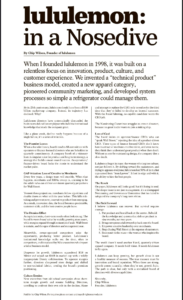Should AI-Generated Content Include a Warning Label?
Like a tag that warns sweater owners not to wash their new purchase in hot water, a virtual label attached to AI content could alert viewers that what they’re looking at or listening to has been created or altered by AI. While appending a virtual identification label to AI-generated content may seem like a simple, logical solution to a serious problem, many experts believe that the task is far more complex and challenging than currently believed. The answer isn’t clear-cut, says Marina Cozac, an assistant professor of marketing and business law at Villanova University’s School of Business. “Although labeling AI-generated content … seems like a logical approach, and experts often advocate for it, findings in the emerging literature on information-related labels are mixed,” she states in an email interview. Cozac adds that there’s a long history of using warning labels on products, such as cigarettes, to inform consumers about risks. “Labels can be effective in some cases, but they’re not always successful, and many unanswered questions remain about their impact.” For generic AI-generated text, a warning label isn’t necessary, since it usually serves functional purposes and doesn’t pose a novel risk of deception, says Iavor Bojinov, a professor at the Harvard Business School, via an online interview. “However, hyper-realistic images and videos should include a message stating they were generated or edited by AI.” He believes that transparency is crucial to avoid confusion or potential misuse, especially when the content closely resembles reality. Related:Breaking Down Barriers to AI Accessibility Real or Fake? The purpose of a warning label on AI-generated content is to alert users that the information may not be authentic or reliable, Cozac says. “This can encourage users to critically evaluate the content and increase skepticism before accepting it as true, thereby reducing the likelihood of spreading potential misinformation.” The goal, she adds, should be to help mitigate the risks associated with AI-generated content and misinformation by disrupting automatic believability and the sharing of potentially false information. The rise of deepfakes and other AI-generated media has made it increasingly difficult to distinguish between what’s real and what’s synthetic, which can erode trust, spread misinformation, and have harmful consequences for individuals and society, says Philip Moyer, CEO of video hosting firm Vimeo. “By labeling AI-generated content and disclosing the provenance of that content, we can help combat the spread of misinformation and work to maintain trust and transparency,” he observes via email. Related:Why Enterprises Struggle to Drive Value with AI Moyer adds that labeling will also support content creators. “It will help them to maintain not only their creative abilities as well as their individual rights as a creator, but also their audience’s trust, distinguishing their techniques from the content made with AI versus an original development.” Bojinov believes that besides providing transparency and trust, labels will provide a unique seal of approval. “On the flip side, I think the ‘human-made’ label will help drive a premium in writing and art in the same way that craft furniture or watches will say ‘hand-made’.” Advisory or Mandatory? “A label should be mandatory if the content portrays a real person saying or doing something they did not say or do originally, alters footage of a real event or location, or creates a lifelike scene that did not take place,” Moyer says. “However, the label wouldn’t be required for content that’s clearly unrealistic, animated, includes obvious special effects, or uses AI for only minor production assistance.” Consumers need access to tools that don’t depend on scammers doing the right thing, to help them identify what’s real versus artificially generated, says Abhishek Karnik, director of threat research and response at security technology firm McAfee, via email. “Scammers may never abide by policy, but if most big players help implement and enforce such mechanisms it will help to build consumer awareness.” Related:Why Every Employee Will Need to Use AI in 2025 The format of labels indicating AI-generated content should be noticeable without being disruptive and may differ based on the content or platform on which the labeled content appears, Karnik says. “Beyond disclaimers, watermarks and metadata can provide alternatives for verifying AI-generated content,” he notes. “Additionally, building tamper-proof solutions and long-term policies for enabling authentication, integrity, and nonrepudiation will be key.” Final Thoughts There are significant opportunities for future research on AI-generated content labels, Cozac says. She points out that recent research highlights the fact that while some progress has been made, more work remains to be done to understand how different label designs, contexts, and other characteristics affect their effectiveness. “This makes it an exciting and timely topic, with plenty of room for future research and new insights to help refine strategies for combating AI-generated content and misinformation.” source
Should AI-Generated Content Include a Warning Label? Read More »













